In 1761 the Senate of the Republic of Venice decided to erect an Astronomic Observatory at the University of Padua as a place of search for the Teacher of Astronomy and of exercise for astronomic observations for the students. The major tower of the old Castle of Padua was selected to become the place for such a purpose: it had lost its functions of defence and of jail, that the roman tyrant Ezzelino in 1242, and later the Princes of Padua, the Carraresis in 1375, had wanted for it. To the teacher of astronomy, the abbot Giuseppe Toaldo, it was immediately evident that the tower of the old Castle was the ideal building to turn into "specola" (in Latin specula stands for observatory). It was situated in the southern outskirts of the town, and from its summit the eye could sweep free over the whole southern horizon, so providing an ideal place to the future astronomers for their astronomic observations. It is in fact toward the south, on the celestial meridian, the big ideal circle that passes across the world poles - the points around which the celestial sphere seems to rotate - and across the zenith of a place, the direction of the plumb line - that the stars culminate, that is they reach the highest position above the horizon in their apparent diurnal motion, and therefore they are more easily observable.
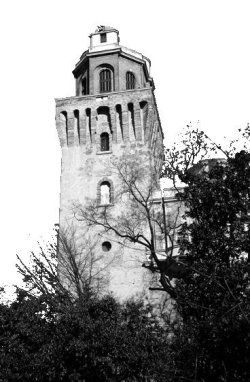 The tower chosen had big and solid wall foundations, it was to be just partly restored so as to give suitable environments where to put the instruments to observe the stars. So the architect Domenico Cerato, on the indications of professor Toaldo, planned a lower observatory, that was 16 meters from the ground and leant against the east side of the tower, and a higher one, 35 meters from the ground, on the merlature level. Up above, the project wanted two small cupolas for other instruments, and a turret for the staircase leading to them.
The tower chosen had big and solid wall foundations, it was to be just partly restored so as to give suitable environments where to put the instruments to observe the stars. So the architect Domenico Cerato, on the indications of professor Toaldo, planned a lower observatory, that was 16 meters from the ground and leant against the east side of the tower, and a higher one, 35 meters from the ground, on the merlature level. Up above, the project wanted two small cupolas for other instruments, and a turret for the staircase leading to them.
The Meridian Room, so the lower observatory was called later, was to be used to measure the exact local midday, on the basis of the meridan line, marked on the floor in 1776 and engraved on a marble slab. On the southern wall, on the vault and on the northern wall, a big cleft was built (now walled up); at night the cleft was opened to measure the positions of the stars in the instant they passed through the celestial meridian. It was for this purpose that, in 1779, the big mural quadrant was bought in London from the famous instrument maker Jesse Ramsden. Still today it is visible in the room, even if no longer in its original position, equipped with a telescope with achromatic lens by Dollond. For the same purpose, in the northern side of the room, in correspondence of the celestial meridian, it was placed an instrument for the transits and an instrument to measure the exact instant of the transit in meridian of a celestial body, with the astronomic clock regulated on the apparent movement of the stars. As a matter of fact, it is in this way that a star coordinate called 'right ascension' is drawn.
Some pendulum clocks were placed in every observation room (and are still there). The measuring of time has always been "astronomers' matter ": by the movement of the Sun the "solar time" is measured; by the movement of the stars, the 'sideral ' one, and by the latter, the position of the stars in the celestial sphere can be established. That's why, since the most ancient times, in any Observatory, clocks have never been missing.
The terrace above the Meridian Room was intended for the meteorological observations thanks to the instruments here located: in fact, up to the beginnings of this century, it was task of the astronomer to record day by day, the temperature, the pressure, the quantity of fallen water in case of rain, to signal the state of the sky - clear or cloudy - and of the winds.
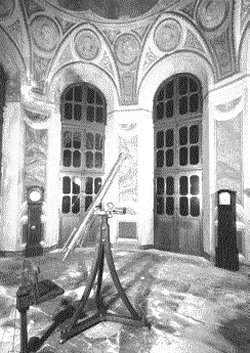 In 1836 a small octagonal pavilion was built on the same terrace to set up the meridian circle, a more precise instrument respect to the ones used in the 18th century, used to measure the transits of the stars. It was thanks to this instrument that Giovanni Santini, director of the Specola from 1817 to 1877, measured, together with his collaborators, the positions of about ten thousand stars, today collected in the Paduan Catalogues
In 1836 a small octagonal pavilion was built on the same terrace to set up the meridian circle, a more precise instrument respect to the ones used in the 18th century, used to measure the transits of the stars. It was thanks to this instrument that Giovanni Santini, director of the Specola from 1817 to 1877, measured, together with his collaborators, the positions of about ten thousand stars, today collected in the Paduan Catalogues
The higher observatory room was called the Picture Room, after the decorations painted on the walls and on the vault since the origins of the Specola. The '700 frescos show the recently restored full-size portraits of eight great personalities in the astronomy of the past, while the vault, irreparably ruined during the years, shows 16 medallions with portraits representing partly the same characters of the walls, partly the great mathematicians who had been giving an extraordinary contribution to more and more precise calculations in the 700-800 hundreds: they had given a relevant step forward to the astronomic calculations of the exact position of cometary orbits and of new planets and minor planets.
The room, of octagonal shape, eight-metre tall with six great windows almost 6 meters high, with originary re-entering shutters in the wall, was originally intended for astronomic observations with telescopes of different type, which could be turned towards whatever direction of the sky, and could also be used by going out onto the surrounding square-shaped terrace. In this room there are18th and 19th century telescopes, all mounted on solid wooden supports, the heaviest of them equipped with wheels, in order to be more easily moved towards the side of the horizon that was to be observed.
In 1858 a third small cupola was built on top of the third tower and replaced the staircase turret. A new telescope was put there, bigger and more powerful then ever before!
That's how the most ancient nucleus of the old Castle and the terrible tower-jail of the tyrant Ezzelino of 1242 were transformed in favour of Science, where the instruments of the astronomers of the past are still placed in the same places they were used in.
In fact, a commemorative headstone dated 1767, year of beginning of the restoration works, says:
MCCXLII / QUAE QUONDAM INFERNAS TURRIS DUCEBAT AD UMBRAS NUNC VENETUM AUSPICIIS PANDIT AD ASTRA VIAM / MDCCLXVII
(1242 / this tower that once led to the infernal shades now under the auspices of the venetians paves the way to the stars / 1767)
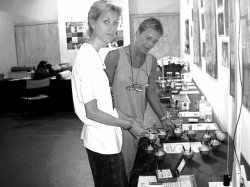 GEI has been carried out by the Research Group for the Didactis of Physics: a first edition of 60 exsperiments was thought by Marisa Michelini, carried out by Plinio de Zorzi on a progect by Maritza Bosia, Maria Carla Maccario, Marisa Michelini e Maria Luisa Scillia. Later it was enlarged by Giulietta Bosatta, Stefania Bosio, Giuliana Candussio, Vilma Capocchiani, Donatella Ceccolin, Lorenzo Marcolini, Marisa Michelini, Gian Luigi Michelutti, Silvia Pugliese, Mauro Sabbadini, Lorenzo Santi, Chiara Sartori ed Alberto Stefanel.
GEI has been carried out by the Research Group for the Didactis of Physics: a first edition of 60 exsperiments was thought by Marisa Michelini, carried out by Plinio de Zorzi on a progect by Maritza Bosia, Maria Carla Maccario, Marisa Michelini e Maria Luisa Scillia. Later it was enlarged by Giulietta Bosatta, Stefania Bosio, Giuliana Candussio, Vilma Capocchiani, Donatella Ceccolin, Lorenzo Marcolini, Marisa Michelini, Gian Luigi Michelutti, Silvia Pugliese, Mauro Sabbadini, Lorenzo Santi, Chiara Sartori ed Alberto Stefanel.
Today it includes 120 simple experiments on mechanics, thermology and heat, electrostatics, electrodynamics, electromagnetism, optics, chemistry and astronomy, carried out using poor material easily available in every day life and new technologies such as sensors with computer on line.
It offers a very informal way to help teaching, a way of making activities, of playing, trying, experimenting, ... exploring ideas to explore phenomena. More than an exhibition to watch, it is an exhibition to use inside and outside the school, to understand and analize phenomena. It has been prepared so that boys and girls could work on it with their teachers alone or in groups, with their schoolfellows or other boys, with university researchers or with their parents.
It can be bent to the teachers in their schools, enriching scientific teaching with operating occasions.The semplicity of its equipment makes it familiar to any user, who does not hesitate to act, to explore ideas to make simple experiments answering the questions of the several enclosed sheets. GEI stimulates the operativeness on the individual discovery as a game, causing the personal involvement that is so important in the learning of scientific subjects, in particular when forming the basic knowledge of the student where the greatest effort for the development of a scientific culture is required.The experiments allow the acquiring of the basic scientific knowledge and the organisation of monothematic didactic progect. Without being complete they show the right way to ask questions, to use knowledge and abilities to get suitable answers through proper experiences.
It is suggested for individual experimental exploration or for small groups both in expositive context and in class.
Six kinds of cards go with each equipement of the exhibition, that can be arranged in thematic groups according to different routes. They are: a) captions of the photographs of the materials shown; b) hints: short, easy to read cards with an immediate operative idea; c) guided
considerations: one page cards offering simple activities for single subjects; d) teacher cards: detailed suggestions to the teacher for the use of materials in different didactic activities; e) directions: conceptual frameworks explaining the exposed operative suggestions; f) EIC: suitable for a real survey on the operator's way of learning. Other materials such as a video, little software, ipertexts on didactic experiments are increasing together with GEI efforts.
Some suggestions for didactics routes have been studied during the work experience performed with the show. Others have been developed and employed at school during 26 courses for teachers' training.
The possibility of free borrowing of the material have offered a great service activity around GEI. It has been shown with regular contracts to different realities in 33 occasions in 19 different places also important such as the Museo Nazionale della Scienza e della Tecnica di Milano e il Museo della Bilancia - Centro Nazionale di documentazione di Modena - where it was visited by 33.000 students, 3700 teachers, 1400 experts in didactic research not only from Europe but also from international context. As you can imagine the same activity is done through informal agreements.
The seat of different didactic researches: a) development of prototypes of experiments, b) curricular courses, c) knowledge development, d) teachers' formation has produced 22 researches, 7 of which at an international level. Last September, in Salerno, the Italian Society of Phisics gave Marisa Michelini the price for Didactics for the realisation and the activities of the exhibition GEI and of the Laboratory Centre for the Didactics of Phisics, to which the exhibition refers at the CIRD of the Universitiof Udine. For informal training and distance formation also of teachers they have been carrying out a multimedia-interactive prototype avaliable on internet (GEIWEB).
Interested people can adress to Donatella Ceccolin at the CIRD of the University of Udine (tel. 0432 558211, fax 0432 558222) or send a message to GEI@fisica.uniud.it. It is also possible to visit GEI in http://www.fisica.uniud.it/GEI.
We hope that the exhibition may increase going around, because that would be the evidence of its utility for the school
to FIAT staff in Venezia St. for the kindly hospitality offered at the 160 students who were waiting for the practical exam
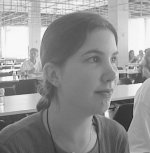 The noise increases in the "Piovego" canteen. The tension decreases and the hunger too. We go near the Finlandian table and we ask the same questions as we had asked Minttu Uotila "It was difficult enough, but the text was more clear than in past exam papers".
The noise increases in the "Piovego" canteen. The tension decreases and the hunger too. We go near the Finlandian table and we ask the same questions as we had asked Minttu Uotila "It was difficult enough, but the text was more clear than in past exam papers".
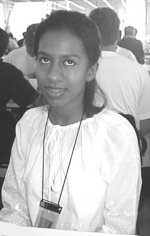 We thank her guide who helped us in the interview and we go near the Kuwait team. At our arrival they smile with embarassment for the camera's presence. "What do you think about the exam of this morning?" "Difficult" "Was it very or just a little difficult?" we press... "Difficult" answer in a succinct but serene way.
We thank her guide who helped us in the interview and we go near the Kuwait team. At our arrival they smile with embarassment for the camera's presence. "What do you think about the exam of this morning?" "Difficult" "Was it very or just a little difficult?" we press... "Difficult" answer in a succinct but serene way.
 What did you think about the exam this morning?" "It wasn't very hard" answers Shervan Fashandi, one of the Indonesian group. "Was the text difficult?" "No, I haven't got any problems. The text was quite explicit".
What did you think about the exam this morning?" "It wasn't very hard" answers Shervan Fashandi, one of the Indonesian group. "Was the text difficult?" "No, I haven't got any problems. The text was quite explicit".
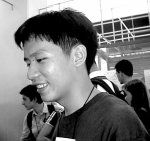 The students' expressions denoted their happiness for the first exam's conclusion, but first it is time to feed their appetite. The queue for the lunch increases ,so we can take advantage to ask Yeo Wenzheng, from Singapore, his opinion. "It was difficult, but there wasn't any problems with the text.The only objection is that there wasn't enough time". This is normal: there isn't enough time for such a challenging test, especially for the careful students. We would like to ask something else, but the queue moves on and to avoid losing his place, we left our nice companion.
The students' expressions denoted their happiness for the first exam's conclusion, but first it is time to feed their appetite. The queue for the lunch increases ,so we can take advantage to ask Yeo Wenzheng, from Singapore, his opinion. "It was difficult, but there wasn't any problems with the text.The only objection is that there wasn't enough time". This is normal: there isn't enough time for such a challenging test, especially for the careful students. We would like to ask something else, but the queue moves on and to avoid losing his place, we left our nice companion.
 The tower chosen had big and solid wall foundations, it was to be just partly restored so as to give suitable environments where to put the instruments to observe the stars. So the architect Domenico Cerato, on the indications of professor Toaldo, planned a lower observatory, that was 16 meters from the ground and leant against the east side of the tower, and a higher one, 35 meters from the ground, on the merlature level. Up above, the project wanted two small cupolas for other instruments, and a turret for the staircase leading to them.
The tower chosen had big and solid wall foundations, it was to be just partly restored so as to give suitable environments where to put the instruments to observe the stars. So the architect Domenico Cerato, on the indications of professor Toaldo, planned a lower observatory, that was 16 meters from the ground and leant against the east side of the tower, and a higher one, 35 meters from the ground, on the merlature level. Up above, the project wanted two small cupolas for other instruments, and a turret for the staircase leading to them.
 In 1836 a small octagonal pavilion was built on the same terrace to set up the meridian circle, a more precise instrument respect to the ones used in the 18th century, used to measure the transits of the stars. It was thanks to this instrument that Giovanni Santini, director of the Specola from 1817 to 1877, measured, together with his collaborators, the positions of about ten thousand stars, today collected in the Paduan Catalogues
In 1836 a small octagonal pavilion was built on the same terrace to set up the meridian circle, a more precise instrument respect to the ones used in the 18th century, used to measure the transits of the stars. It was thanks to this instrument that Giovanni Santini, director of the Specola from 1817 to 1877, measured, together with his collaborators, the positions of about ten thousand stars, today collected in the Paduan Catalogues
 GEI has been carried out by the Research Group for the Didactis of Physics: a first edition of 60 exsperiments was thought by Marisa Michelini, carried out by Plinio de Zorzi on a progect by Maritza Bosia, Maria Carla Maccario, Marisa Michelini e Maria Luisa Scillia. Later it was enlarged by Giulietta Bosatta, Stefania Bosio, Giuliana Candussio, Vilma Capocchiani, Donatella Ceccolin, Lorenzo Marcolini, Marisa Michelini, Gian Luigi Michelutti, Silvia Pugliese, Mauro Sabbadini, Lorenzo Santi, Chiara Sartori ed Alberto Stefanel.
GEI has been carried out by the Research Group for the Didactis of Physics: a first edition of 60 exsperiments was thought by Marisa Michelini, carried out by Plinio de Zorzi on a progect by Maritza Bosia, Maria Carla Maccario, Marisa Michelini e Maria Luisa Scillia. Later it was enlarged by Giulietta Bosatta, Stefania Bosio, Giuliana Candussio, Vilma Capocchiani, Donatella Ceccolin, Lorenzo Marcolini, Marisa Michelini, Gian Luigi Michelutti, Silvia Pugliese, Mauro Sabbadini, Lorenzo Santi, Chiara Sartori ed Alberto Stefanel.